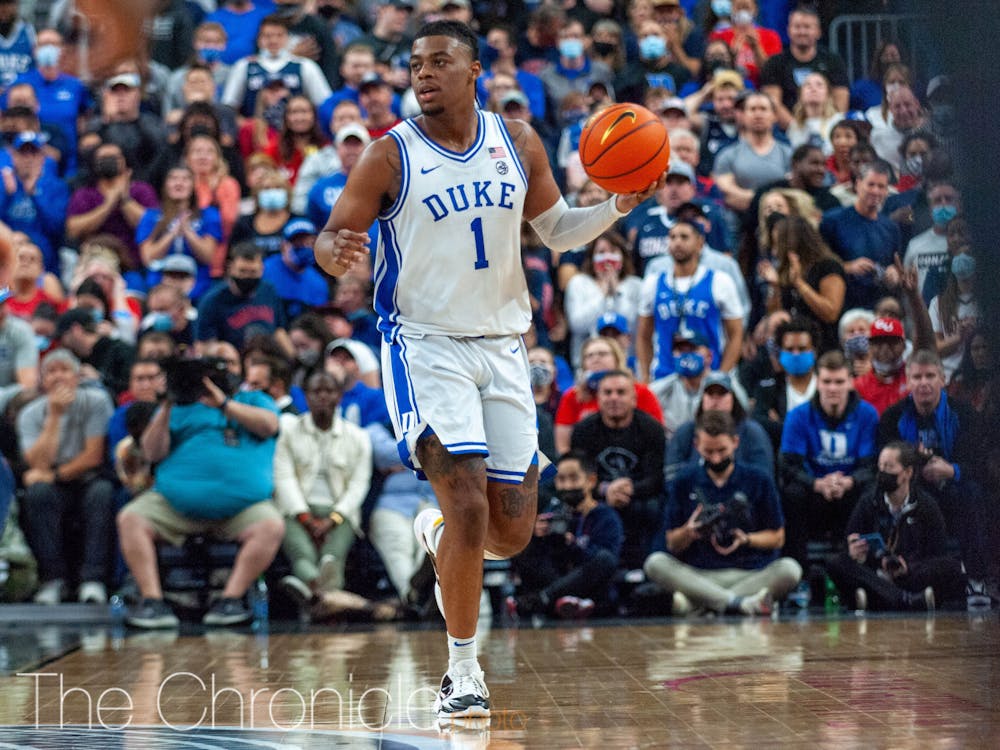After more than a month of speculation, Trevor Keels decided to remain in the 2022 NBA Draft ahead of Wednesday night’s NCAA deadline to withdraw from the selection pool. That spells the end of the 2021-22 ACC All-Freshman guard’s Duke career after he left the door open for a potential sophomore return, leaving a backcourt spot open alongside rising junior point guard Jeremy Roach.
With Keels officially bound for the NBA, The Chronicle’s Jonathan Levitan, Micah Hurewitz and Max Rego are here to discuss what this news means for the Blue Devils in 2022-23.
What does Keels’ decision mean for Scheyer’s first Blue Devil roster?
Levitan: Duke’s roster suddenly feels much younger. Despite adding a pair of graduate transfers, Keels’ departure cuts the list of returning starters to one. Scheyer and his young staff still have an undeniably talented group consisting mainly of freshmen, but without Keels in the fold, it’s even harder to sense what these new Blue Devils will look like.
Keels, to be quite clear, is a big loss for Duke, and he leaves a considerable void to be filled. This is more than a wrinkle to Scheyer’s first season leading the charge, but a real challenge for him and his staff to overcome.
Rego: That Jeremy Roach will carry an even larger burden in the backcourt, from a scoring, playmaking and defensive standpoint. Put simply, Roach is going to have the ball in his hands. A lot. Plus, no Keels means that Scheyer will have to search elsewhere if he wants to have the same lineup flexibility that former head coach Mike Krzyzewski had last year.
Duke often featured four ball handlers on the floor in its run to the Final Four, a trademark component of its offensive arsenal. Roach, Keels, Dariq Whitehead and Mark Mitchell could have conceivably shared the floor alongside one of the three Blue Devil bigs—Dereck Lively II, Kyle Filipowski or Ryan Young—but that is now off the table. Without a transfer guard to provide immediate two-way viability, Duke will likely struggle to be a true national contender.
Hurewitz: A freshman-heavy squad will have to use young players even more. And maybe that’s not a bad thing with the several five-stars that could compete on their own. But that also means a lot more work for guys like Roach, as Jonathan and Max astutely pointed out. The backcourt is slim, but toward the end of last season, Roach looked like he could become the true point guard and he will just have to run with that role this coming season.
The most successful Duke teams have been ones that play very good perimeter defense and shoot threes. Roach is a good defender and a decent shooter, but no one else on the roster as of now can truly fill that 3-and-D role it feels like the team needs.
Who will be Duke’s starting shooting guard in 2022-23?
Levitan: Courtney Ramey. After Northern Iowa guard and Duke target AJ Green decided to stay in the draft Wednesday, it looked as if the Blue Devils might not have another shot at a high-level transfer-portal addition to pair with Roach. But Stadium’s Jeff Goodman reported shortly after that Ramey, a three-time All-Big 12 selection at Texas who withdrew from the draft early Wednesday, is “in play” for Duke.
Ramey has been a point guard his whole career with the Longhorns and isn’t a no-brainer to slide in next to the 6-foot-2 Roach. That might present some matchup challenges for the duo, but it shouldn’t prevent what would be an exciting pairing of veteran defenders and playmakers. Where there’s smoke, there’s fire, and all signs point toward the Blue Devils making a push for Ramey.
Rego: Whether it’s Ramey or another transfer, I can pretty safely say that it will be someone not currently in the program. Isiaih Mosley (Missouri State) and Malachi Smith (Chattanooga), the respective No. 1 and No. 3 available transfers according to The Athletic, are still out there, and a phone call to each is worth it. Both hovered around 20 points a night, albeit at mid-majors, and can get buckets from distance.
Fitting in alongside Roach, Whitehead and other highly talented scorers would take some adjusting, though, as Mosley and Smith had whopping usage rates of 32% and 28%, respectively, last season. Ramey is the most likely option, particularly after Houston, which Goodman reported was also in the mix for the Texas transfer, secured All-AAC guard Marcus Sasser for another season. But there are other options out there, giving Scheyer and his staff a chance to add a dynamic backcourt piece—if they move quickly.
Hurewitz: I am in love with the idea of Scheyer grabbing someone from the transfer portal. With the amount of talent still remaining in the portal and Green heading to the draft, it seems natural that the second backcourt spot is filled by someone not currently signed on to Duke. Ramey is an option, as are Mosley and Smith (should Scheyer agree with our assessment), but I still think that, like with Keels and Green, the cards won’t fall in Duke’s favor here.
We knew from the get-go that this year’s team would be a big one. With Lively and Filipowski filling out the frontcourt, I am beginning to imagine that Duke’s opening night lineup includes Dariq Whitehead and Mark Mitchell. Whitehead brings explosiveness out of the backcourt—even though he’s listed as a small forward—and has played as a primary ball-handler at multiple national events against top-notch competition. He is a top recruit and it may not be the ideal fit, but he could very well end up in that two-guard role.
What does Keels’ NBA potential look like heading into the draft?
Levitan: Keels’ decision came down to the wire—he was among the final few players to confirm his draft status Wednesday—and that is more than likely because of enticing arguments in favor of both options. His draft profile isn’t bulletproof and his stock isn’t as high as it once was or could be this time next year, but he typically picked the right moments in his lone season in Durham to show his star potential. Most will point to his brilliant debut against Kentucky, but Keels’ 19 points and level of pure fight in Duke’s ultra-competitive Final Four loss to North Carolina is enough evidence for me that Keels belongs in the NBA right now, no matter where he ends up being selected.
Rego: The consensus among draft analysts is that Keels is a late-first/early-second round prospect, which feels about right. Keels’ measurables at the combine are major deterrents for teams that might otherwise be enticed by his ball screen prowess, ability to finish through contact and youth, clearly indicating that there are pros and cons to drafting the former five-star. All that being said, I think given time, Keels can succeed in the right situation. The G League might be in the cards for much of his rookie campaign, but if the St. Paul VI alum joins an organization with an elite player development system, he could carve out a rotation role in the Josh Hart mold. San Antonio, Miami, Golden State and Toronto, all of whom have picks from 25-38 (in the Spurs’ case, two), would be ideal fits.
Hurewitz: His NBA stock now is nowhere near where it was after Nov. 9 against Kentucky. The 25-point showing against Kentucky looked like the start of something special, but Keels only hit that scoring mark twice through the rest of the season and his draft stock continued to tumble thanks to a poor combine showing. Clearly, I am a believer that he could have benefited greatly from another year in Durham, but if I have to make an estimate of his NBA abilities, it looks like he will fall in the late second round as a future investment pick. He has shown flashes of being able to use his body to compete with bigs down low and defend, but I agree with Max that he may need an elite development system in order to reach his ceiling.
Get The Chronicle straight to your inbox
Sign up for our weekly newsletter. Cancel at any time.
Editor's note: Malachi Smith committed to Gonzaga shortly after the publication of this article Thursday.
Jonathan Levitan is a Trinity senior and was previously sports editor of The Chronicle's 118th volume.
Micah Hurewitz is a Trinity senior and was previously a sports managing editor of The Chronicle's 118th volume.

Max Rego is a Trinity senior and an associate sports editor for The Chronicle's 118th volume. He was previously sports managing editor for Volume 117.

